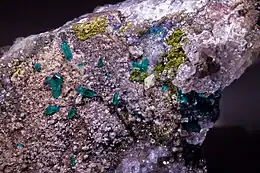Fornacite
Fornacite is a rare lead, copper chromate arsenate hydroxide mineral with the formula: Pb2Cu(CrO4)(AsO4)(OH). It forms a series with the phosphate mineral vauquelinite.[3] It forms variably green to yellow, translucent to transparent crystals in the monoclinic - prismatic crystal system. It has a Mohs hardness of 2.3 and a specific gravity of 6.27.
| Fornacite | |
|---|---|
 Dioptase (blue green), cerussite (light pink) and fornacite (green) from Renéville, Djoué, Brazzaville Region, Republic of Congo | |
| General | |
| Category | Arsenate mineral |
| Formula (repeating unit) | Pb2Cu(CrO4)(AsO4)(OH) |
| IMA symbol | For[1] |
| Strunz classification | 7.FC.10 |
| Dana classification | 43.4.3.2 |
| Crystal system | Monoclinic |
| Crystal class | Prismatic (2/m) (same H-M symbol) |
| Space group | P21/c |
| Unit cell | a = 8.101(2), b = 5.893(11), c = 17.547(9) [Å]; β = 110.00(4)°; Z = 4 |
| Identification | |
| Color | Deep olive-green |
| Crystal habit | Aggregates of steep pyramidal to bladed, rounded crystals |
| Fracture | Irregular/uneven, conchoidal, sub-conchoidal |
| Tenacity | Brittle |
| Mohs scale hardness | 2 - 3 |
| Luster | Resinous, waxy, greasy |
| Streak | Olive green |
| Diaphaneity | Transparent |
| Density | 6.27 g/cm3 |
| Optical properties | Biaxial (+) |
| Refractive index | nα = 2.142 nγ = 2.242 |
| Birefringence | δ = 0.100 |
| 2V angle | Large |
| References | [2][3][4] |
It was first described in 1915 and named after Lucien Lewis Forneau (1867–1930) the governor of the French Congo. Its type locality is in Reneville, Republic of Congo.[3]
It occurs in the oxidized zone of ore deposits and is associated with dioptase, wulfenite, hemihedrite, phoenicochroite, duftite, mimetite, shattuckite, chrysocolla, hemimorphite, willemite and fluorite.[2]
References
- Warr, L.N. (2021). "IMA–CNMNC approved mineral symbols". Mineralogical Magazine. 85 (3): 291–320. Bibcode:2021MinM...85..291W. doi:10.1180/mgm.2021.43. S2CID 235729616.
- Handbook of Mineralogy
- Mindat with locations
- Webmineral data
This article is issued from Wikipedia. The text is licensed under Creative Commons - Attribution - Sharealike. Additional terms may apply for the media files.